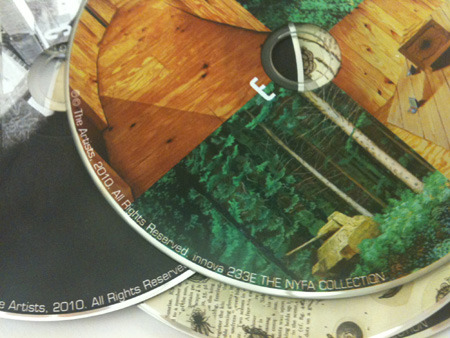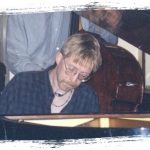The Business of Art: A Conversation with Cristian Amigo and Philip Blackburn
CDs from The NYFA Collection. Photo: Daniel Wentworth.
Innova Recordings has just released The NYFA Collection: 25 Years of New York New Music anthology. This collection, comprised of a five-CD set, came out of an idea put forth from composer Cristian Amigo, one of NYFA’s Artist’s Advisory Committee members, and Innova director/composer Philip Blackburn, who together spent countless hours producing and curating this collection of music featuring unique and varied artistic voices from 52 NYFA Fellows over the past 25 years. Here, David C. Terry, Senior Officer/Curator at NYFA, talks with Amigo and Blackburn on how this unique and significant piece of our nation’s musical heritage came to be.
David Terry: Tell me a little bit about both of you, and what, exactly, is Innova?
Cristian Amigo: Well, I’m a composer, guitarist, and producer in the New York City new music, theater, and improvisation community. I’m also interested in Latin American and American roots music. My latest project is in the band BRIM that consists of myself on guitars, Eve Beglarian on vocals and miscellaneous instruments, and Mary Rowell from ETHEL on violin and mandolin. It’s a new music band with a roots kind of instrumentation. I play acoustics and archtop electric.
Philip Blackburn: I’m an experimental composer (environmental sound-artist, some say) with a British accent who fell into arts administration at the American Composers Forum (ACF) before you were born. I assist composers in their careers, sometimes by helping toss grant money their way, sometimes by holding their hands through the thorny thickets of the recording industry.
Innova Recordings was born out of ACF in 1982, originally as a way to document winners of our McKnight Composer Fellowship Program (so it’s not so different from NYFA in that way). Our model is very artist-friendly; artists keep all their rights and 100 percent of all income.
DT: With so many musicians featured on this collection, how did you come up with the logic for organizing it?
CA: Oy! Philip proposed the final categories as we were selecting tracks. The categories are A, B, C, D, and E—that’s the politically and aesthetically safe answer.
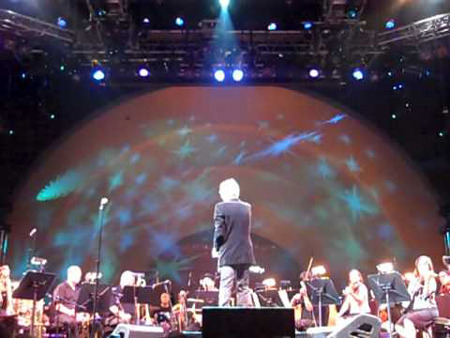
JG Thirlwell is featured on CD B of The NYFA Collection.
PB: The mysterious art of sequencing—it’s the quality that Abbey Road has but nobody really needs anymore now that they shuffle tracks around in their players… I started by grouping soundworlds, kinds of energy (rousers, soothers), musical forces and languages, and strung them out into a six-hour pathway. You’ll find clumps of flutes, strings, jazzy vibes, noisy stuff, and mellow listenable zones along the journey, so if there are listeners who don’t like the first crunchy disc, they can try another smoother one. Or you can jump to the names you recognize and find others nearby. It’s an education as much as a strenuous but rewarding ear-hike.
DT: How did the idea for this project develop?
PB: Innova had released a Cristian Amigo album a while ago, funded by a New York State Music Fund grant. Doing his job as NYFA booster, he suggested we put out another release (the Hildegurls’ Electric OrdoVirtutum) that also featured NYFA folks. He told me that there was a whole throng of such Fellows, and we got the idea to ask the NEA for funding for a compilation drawing from this pool of pre-vetted talent.
DT: Had you worked as producers together in the past?
CA: This is our first joint venture as producers but we’ve known each other for about eight years. I worked with Philip on releasing my first solo CD, Kingdom of Jones, in 2008. Also, some years ago I received a Jerome Foundation commission from the American Composers Forum (that Innova is part of), which provided me with an important early opportunity in my career as a composer. Philip was managing that program at the time.
DT: What was challenging about putting this compilation together?
CA: The overwhelming response and immense variety of music that the collection finally contained. How do you thematically weave all these disparate strands into a whole? That was the hardest thing. Philip’s experience really helped in this regard. He has the experience and the ear for putting these kinds of things together. Together, we worked it out.
PB: I think that the hardest parts were finding contact info for everyone from the last 25 years, managing the four-inch stacks of contracts, bios, liner notes, and permissions, and chasing after delinquent late-comers.
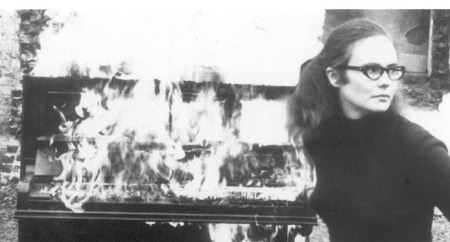
Annea Lockwood is featured on CD B of The NYFA Collection.
DT: How much planning was involved and how long did it all take to get The NYFA Collection together?
CA: It was a couple of years from initiation to release. I proposed the idea to Philip first and then to NYFA. I guess I brokered the early relationship between all the parties. Then there was the fundraising phase that Innova took the lead on. That’s when the NEA came in with the money to make it all possible.
PB: The NEA grant was submitted in 2008, and once it was approved, maybe about seven months ago, Cristian and I added about 30 percent to our daily workload. Luckily it has been worth it and we’ve made many new friends along the way.
DT: What was the most fun about the project?
PB: Sharing new tracks with Cristian and seeing if we felt the same way about the music. Also, the willingness and generosity we encountered from the composers, performers, and everyone else who were more than happy to contribute to the NYFA cause and to this important time capsule. I hope it receives the jaw-dropping acclaim that all the recordings deserve. They should be required listening for every music student whose textbooks peter out after 1945.
CA: It was really fun to see how the pieces fell into place and the excitement of the artists and the folks at NYFA, ACF, Innova, and the NEA. A total rush. Also, receiving all of this new “new” music.
DT: How do you deal with the artists’ royalties?
PB: We offered to pay mechanical royalties up front on all the physical discs; many artists were kind enough to waive them so we could redirect that funding for further promo efforts. Digital mechanicals happen at the DSP at the time of download.
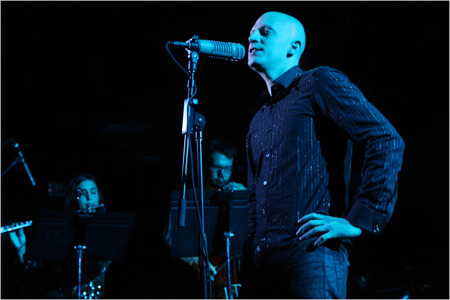
Corey Dargel appears as a guest performer on Eve Beglarian’s “We Two,” featured on CD D of The NYFA Collection.
DT: Was it difficult working with so many different artists?
PB: Keeping track of the sheer quantity and variety required a lot of organizational planning. The NYFA Collection was originally going to be six separate discs, then a four-CD set, but we settled on a five-CD set with four whole single-artist albums (the Series). It felt like a thrilling victory every time our heroes responded to our humble requests with available tracks. Nobody threw ego tantrums as we Minnesotans were led to expect from New York divas…
DT: Do you believe this is an important piece of musical/historical documentation?
CA: I do, and this was the initial impetus for making this collection a reality. I assumed something like this already existed. When I found out that it didn’t, I knew that I wanted to do it.
PB: Fifty-two peer-approved artists who all participated in some part of the cultural life of New York State during the last quarter of a century—that is quite a slice of a rich and filling pie. With the diversity and the broad tastes of the NYFA panels over the years there is a huge musical range on display with none of the commercial marketing filter you usually find with “best of” anthologies. There is a glut of music out there and tons of good material goes to waste every day. Here is a convenient package that gives credibility to and hard evidence of a vibrant field that is hard to pin down and often flies under the radar. It’s the Rosetta Stone for new music in America.
DT: Do you see yourselves producing this type of compilation again in the future?
CA: This collection came together under very special circumstances; the existence of an important group of composers and artists linked by geography and fellowship to New York City and State. If another documentation project came along, I would definitely work with Philip. I trust him and that’s the best kind of creative partnership. Plus, he’s the organized one.
PB: If there’s a hidden trove of incredible stuff out there and it would be useful to make a statement, then yes, give me a call. In general, sampler albums don’t sell because you like 5 percent and hate the rest. If there’s a unifying theme or purpose then it makes more sense. We can also come back in 25 years, in 2035, and make a NYFA Collection 2.0.
To purchase The NYFA Collection: 25 Years of New York New Music, click here.
Cristian Amigo is an American composer, guitarist, and producer who explores spaces between Western art music (classical and jazz) and all musics. Known as an acoustic and electric guitarist with an improvising bent, Amigo writes and performs avant chamber music, electronic music, opera, theater, film, performance works, fierce riffs, American roots music, and songs. Amigo’s work has been supported by many foundations and public agencies including the John Simon Guggenheim Memorial Foundation, the National Endowment for the Arts, and Meet the Composer. Cristian has a Ph.D. in ethnomusicology from UCLA. He is currently composer-in-residence at INTAR Theatre (NYC) and is a visiting scholar in NYU’s Latino Studies Department.
Philip Blackburn was born in Cambridge, England, and studied music there as a Choral Scholar at Clare College. He earned his Ph.D. in Composition from the University of Iowa where he studied with Kenneth Gaburo and began work on publishing the Harry Partch archives. Blackburn’s book Enclosure Three: Harry Partch, won an ASCAP Deems Taylor Award. He has worked at the American Composers Forum since 1991, running the Innova Recordings label and developing re-granting programs and opportunities for composers. He is also a composer/environmental sound artist and has served as teaching artist for school residencies connected with the Flint Hills International Children’s Festival, creating multimedia performances using homemade instruments.

